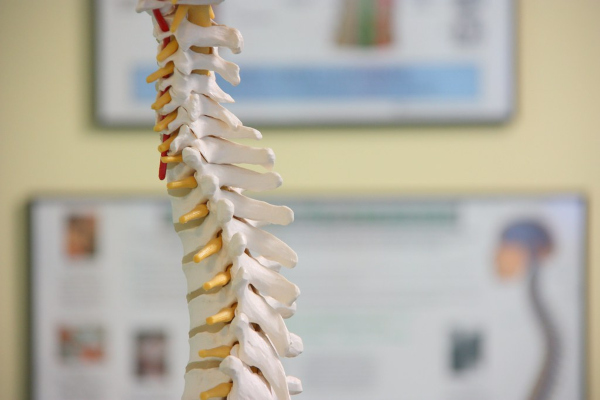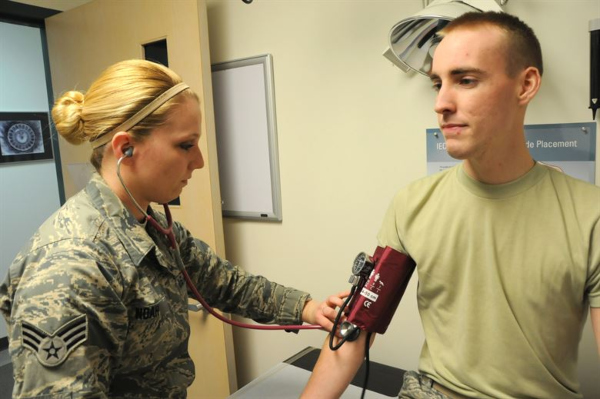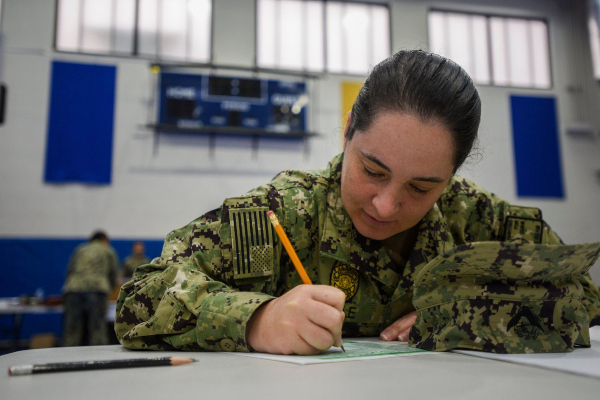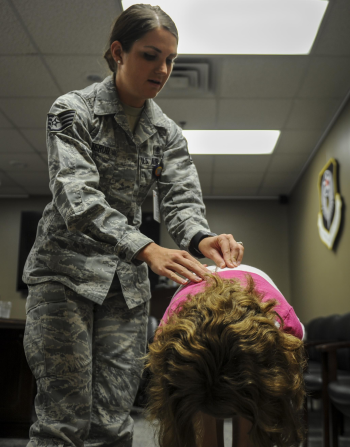Scoliosis is a serious medical condition that affects the curvature of the spine.
The disorder is troubling because it most often occurs during a growth spurt right before puberty.
Consequently, many teens and young adults begin dealing with the condition in a short amount of time before they consider enlisting in the U.S. Armed Forces.
Can you join the military with scoliosis?
Every military branch treats scoliosis slightly differently, which makes it best to consult the policy of every branch you are considering before enlistment.
Related Article – Can You Join The Military With Autism?
What is Scoliosis?

Scoliosis is a sideways curvature of the spine that is linked to cerebral palsy and muscular dystrophy.
However, not every case of scoliosis is severe, and many people are able to live a full life and still do things like serving in the military.
The condition affects about 3% of adolescents with some cases having the threat of forming more progressive spine deformities as the body grows.
In addition to limiting or disability movement in severe cases, scoliosis may also impact the proper function of the lungs.
Mild forms of scoliosis may not require any treatment, while moderate to severe cases need surgery or other corrective measures.
The signs and symptoms of the disorder include physical ailments like:
- Uneven shoulders
- Uneven waist
- One shoulder blade that is more prominent than the other
- One hip that is higher than the other
Most patients begin seeing a doctor when the symptoms begin as a child.
However, mild forms of scoliosis can develop gradually and without pain.
It is important to seek medical advice because more severe forms of scoliosis may lead to heart and lung damage or back problems.
Scoliosis Disqualifications in the Military
New recruits need to process through a Military Entrance Processing Station (MEPS), which includes a physical examination of their body.
The military uses MEPS to analyze any current medical conditions, especially those that may prevent you from carrying out the full duties and responsibilities of a service member.
While some recruits may not qualify through current DOD standards, it is possible to get waivers for a variety of medical procedures, surgeries, injuries, illnesses, or defects.
Related Article: Your Complete Guide To MEPS
Spinal conditions are a serious matter for the military and many conditions are disqualifying.
Regardless, the military treats every spinal and hip condition on a case-by-case basis.
Three types of spinal curvatures (lordotic, kyphotic, and scoliotic) are analyzed during MEPS.
The following conditions are potentially disqualifying in the U.S. Armed Forces:
- Lumbar Scoliosis
- Thoracic Scoliosis
The Department of Defense considers the curvature or deviation of the spine from normal alignment or function disqualifying when:
- It is symptomatic.
- It prevents you from following a physically active vocation or sports in civilian life.
- The condition prevents you from properly wearing a uniform or military equipment.
- The lumbar or thoracic scoliosis is greater than 30 degrees, or thoracic kyphosis greater than 50 degrees as measured by the Cobb Method.

Army Scoliosis Policy
The U.S. Armed Forces receive an average of 150,000 potential applicants every year.
Each applicant is screened for several things ranging from physical fitness to mental competence to personal background (like a criminal record).
The Army takes a general and vague approach to scoliosis.
After speaking with a recruiter online and inquiring about scoliosis we were notified that:
“All medications and medical conditions must be disclosed to your Recruiter and reviewed by the Chief Medical Officer for a determination of your qualifications.”
You will find a general theme among all military branches that the Department of Defense will handle every case of scoliosis on an individual basis.
Thus, the Army doesn’t take a direct stance on the disorder but it will disqualify you if the military branch believes the condition prevents you from carrying out your duties.
The Army will want to see your complete medical history records.
It is best to remain transparent about the issue to avoid disappointment later on down the road.
Many mild cases of scoliosis get approved by the Army if the condition does not inhibit your ability to perform essential duties of the Armed Forces.
However, it is hard to know for certain until you reach out to an Army recruiter to examine your specific case.
Navy Scoliosis Policy
The U.S. Navy is one of the best branches when it comes to having a clear explanation of how it handles scoliosis.
After speaking with a Navy representative we were directed to the AVMED P-117, Manual of the Medical Department (MANMED).
The manual describes the guidelines for “performing, recording, and interpreting the results of physical examinations conducted for a wide variety of screening and qualifying purposes”.
It explains under Chapter 15-48, Spine and Sacroiliac Joints that these conditions are disqualifying:
“There is lumbar scoliosis greater than 20 degrees, thoracic scoliosis greater than 30 degrees, or kyphosis and lordosis greater than 55 degrees, when measured by the Cobb Method.”
The manual also adds that the condition, unless symptomatic or progressive, “must meet general duty standards”.
Therefore, the Navy assesses scoliosis disorders on a case-by-case basis and primarily takes into account the degree of your curvature to determine qualification.

Air Force Scoliosis Policy
The U.S. Air Force explains that cases of scoliosis are “potentially medically disqualifying.”
However, the final determination is up to the discretion of the doctor overseeing your Military Entrance Processing Station (MEPS) medical evaluation.
Additionally, a local Air Force recruiter can have your medical records for scoliosis prescreened by a doctor at MEPS for a preliminary ruling for more of a heads-up.
While new recruits might find the MEPS process invasive, please keep in mind that it is routine for the military during a screening process to ask in-depth questions about your medical history.
Regardless of the condition, the Air Force requires medical paperwork to allow the Chief Medical Officer (CMO) to make an appropriate decision.
Contact a local Air Force recruiter to find out what paperwork you need to submit and if you should schedule a prescreening.
Related Article – 20 Health Conditions That May Disqualify You From Military
Marine Corps Scoliosis Policy
The Marine Corps was not very helpful when we reached out to them for more information on their individual policy regarding scoliosis.
The representative from the Marines indicated that it is best to speak with a recruiter in your area for more specifics.
Since we personally do not have the disorder the recruiter was not willing to discuss individual eligibility requirements.
Therefore, if you are interested in serving the Marines but have scoliosis, you’ll want to touch base with a recruiter on your own.
Expect the Marines to request all your medical paperwork related to the condition, follow up with personal questions, and potentially want a prescreening before offering you a hard ‘yes’ or ‘no’.
Coast Guard Scoliosis Policy
The U.S. Coast Guard follows similar guidelines to the Navy when it comes to scoliosis.
The military branch factors the degree of the curvature to determine qualification.
As a result, as long as the arch does not exceed 30 degrees, you still qualify.
The official Coast Guard manual related to scoliosis reads:
“There is lumbar or thoracic scoliosis greater than 30 degrees, or kyphosis and lordosis greater than 50 degrees when measured by the Cobb Method.”
Feel free to contact a representative with the Coast Guard if you have additional questions on the matter.
Once again, expect the military branch to follow up with requests for medical records and questions regarding the condition.
Related Article: Can You Join The Military With ADD/ADHD?
Conclusion
The U.S. Armed Forces have decided to handle scoliosis cautiously.
Since the disorder may affect your movement or functioning of the lungs, there is extra caution to make sure the spinal problem is not too severe.
Many people have scoliosis and get by just fine with day-to-day activities.
In general, the military accepts the condition so long as the curvature is within an acceptable range based on the Cobb Method.
The military will also examine if the disorder affects your ability to perform a job or wear a uniform or equipment correctly.
Speaking to a representative from the military branch you are pursuing can help clarify any questions or concerns regarding your specific case.
- Ikon Pass Military Discount: Learn How To Save Big - January 31, 2025
- RTIC Military Discount: Find Out How To Save Big on Gear - January 30, 2025
- Traeger Military Discount: Learn How To Save Big on Smokers - January 28, 2025

